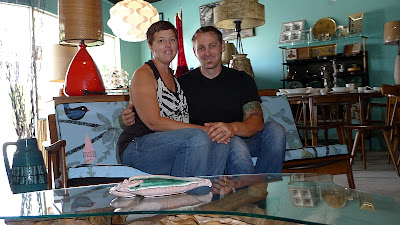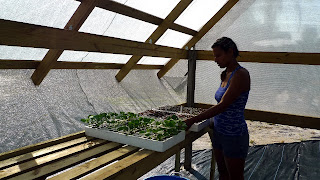Better known for terrorizing toddlers than for catching terrorists, TSA is 'allowing' Sanford/Orlando airport to opt-out of government-sanctioned groping of Florida visitors.
The announcement was made by TSA and U.S. Congressman John Mica (R-FL 7th) at the airport Monday, according to The Sanford Herald. 'As part of the Screening Partnership Program, the Sanford airport will be allowed to use private contract screening services under TSA oversight. “I hope this opens a new era of reform for TSA operations, not only at Orlando Sanford but across nation,” Mica said.'
We hope so too.
For a state which depends on some 85 million annual tourists worth revenues of $60 billion per year, it's about time to give Florida visitors a little dignity along the heavily-traveled air routes to theme park and beach destinations.
It's not like TSA has actually caught any terrorists. They manage to find guns all the time, usually in x-rays of carry on bags and on forgetful passengers, but those could be found with any old-school metal detector.
What the agency does seem good at is picking bad targets for its invasive searches, resulting in viral vids of crying kids and Grandma putting a brave face during her diaper check. If bad publicity is better than no publicity, then Florida airports have TSA to thank for a public image that is equal parts outrage and ewww:
The announcement was made by TSA and U.S. Congressman John Mica (R-FL 7th) at the airport Monday, according to The Sanford Herald. 'As part of the Screening Partnership Program, the Sanford airport will be allowed to use private contract screening services under TSA oversight. “I hope this opens a new era of reform for TSA operations, not only at Orlando Sanford but across nation,” Mica said.'
We hope so too.
For a state which depends on some 85 million annual tourists worth revenues of $60 billion per year, it's about time to give Florida visitors a little dignity along the heavily-traveled air routes to theme park and beach destinations.
It's not like TSA has actually caught any terrorists. They manage to find guns all the time, usually in x-rays of carry on bags and on forgetful passengers, but those could be found with any old-school metal detector.
What the agency does seem good at is picking bad targets for its invasive searches, resulting in viral vids of crying kids and Grandma putting a brave face during her diaper check. If bad publicity is better than no publicity, then Florida airports have TSA to thank for a public image that is equal parts outrage and ewww:
- TSA agents indulged in a bit of imaginative play at Ft. Lauderdale airport in 2009, when they confiscated Pirates of the Caribbean "weapons" from an eight-year-old boy who had recently lost his father to cancer. The youngster was treated to Disney World dream vacation, until TSA confiscated his souvenirs. "It's very upsetting because at one point I had told one of the employees, 'You know this is not a real weapon,' and he said 'Yes, I understand that, it doesn't matter,'" said mom Maria Edge. She said she became even angrier when she saw the TSA officers who had confiscated the items playing with the toy sword and gun. Stay classy, swabbies.
- TSA had a banner year for incidents in 2011, the most famous of which has got to be forcing a 95-year-old woman cancer patient to remove an adult diaper up at Northwest Florida Regional Airport last June.
- That same month, TSA admitted to 'bad judgement' for singling out a mentally disabled 29-year-old for a full bore, terrorist pat-down on his way to the Magic Kingdom. 'David Mandy said agents at Detroit Metro Airport took his son Drew, 29, and asked him about the padding underneath his pants, which turned out to be adult diapers. Drew, who is severely mentally disabled, had trouble understanding the agents’ orders because his family said he has the mental capacity of a 2-year-old,' according to MyFoxDetroit.
- The next month TSA spokesperson issued a statement saying that "As part of our ongoing effort to get smarter about security,” they would be making a “policy decision” that would give security officers more options for resolving screening anomalies with young children.
- Unfortunately, that same day TSA made its promise, agents subjected a a six-year-old boy from Washington state to not one, but two invasive pat-downs while the family was en route to Disney Land in Anaheim, CA. “They just treated him like he was a terrorist,” the boy’s father, Alex Long, told King 5 News. Apparently the kids was carrying a hand-held video game. 'Immediately after this happened, my son, I hugged him and he started crying and saying, ‘I don’t want to go to Disney Land anymore,’” says the child’s mother, Jenine Michaelis.
- "Fear of getting through the lines can kill travel plans," said a South Florida senior. No kidding, Ruth. Ruth Sherman, 89, of Sunrise, was one of three women who said she was forced to disrobe during a secondary screening at New York's John F. Kennedy airport in November. She said she is still angry. "I couldn't go through that again," she said in a Sun Sentinel story.
- Last December TSA cowboys caused a pregnant 17-year-old to miss her flight to Jacksonville -- where her mother was waiting for her -- because the teen's Western-themed purse was embellished with a decoration in the shape of a six gun. They sent the young woman to Orlando instead. Giddy up, Ma, y'all got some driving to do.
- In March TSA screeners refused to allow the father of a visibly shaking three-year-old to hold the boy's hand as he and his wheelchair were swabbed for explosives at Chicago's O'Hare International Airport while the boy and his parents, grandparents, and two siblings were on their way to Walt Disney World. Not exactly the happy family group Disney likes to feature in its advertising. What is the stuff this kid's dreams are made of?
- Last month TSA fired five employees and reprimanded 38 more in the Ft. Meyers airport for goofing off.
These are only TSA incidents with a Florida/attraction angle, just a sampling of TSA operatives' bad judgement.
The agency did get off to a great start this year with arrests of two TSA screeners in Miami for their eBay store, worth $400,000 profits from iPads and other electronics thoughtfully 'donated' by unsuspecting passengers over the past few years.
'Our employees are prohibited from taking backpacks, lunchboxes or any other personal carrying item into baggage screening operation areas,' TSA says on its official blog. All that means is that the thieves among them just target smaller, high priced items. (A TSA baggage screener at LAX was taped attempted to steal a high-priced watch from Paris Hilton, but apparently though the better of it and put the item back. Unfortunately, an average traveler has no such notoriety and is likely to receive no such comparable consideration).
Despite convictions resulting from TSA employee theft rings in N.Y.C., TSA's official blog says that only 200 of their 110,000 employees have been accused of stealing; Shrug. Such a teensy percentage, you should worry? Of course their claim garners a bit less sympathy once it comes out that TSA counts ALL of its employees in order to best skew that ratio. Hey, TSA, if you don't count the pencil pushers in the back office, what's the real percentage of thieves who have access to passenger/luggage frisking areas?
Women passengers routinely complain that TSA officers only seem to confiscate really expensive cosmetics for being outside size limits for liquids and gels, according to Airsafe. Apparently bottles of drug-store make-up get a pass.
Yet in every instance TSA issues the same cookie-cutter press release, defending the actions of its employees as 'professional' and done in a 'sensitive manner'. Really? Exactly how does one check a 95 year-old cancer victim's diaper in a 'sensitive manner?
The reasonable and professional folks at TSA find plenty of probable cause to submit children to nude photography, grope private parts and dose them with radiation because they are heading to Disney World. After all, it's not like U.S. invasions of other countries or American drones killing women and children half a world away could possibly have anything to do with terrorist attacks here.
Here's hoping Mica and the Transportation Committee follow through to push TSA to accept more airport opt-outs.
Rep. Mica wrote some pretty good legislation last year with his bill to stop automatic pay raises for members of Congress; Although he's also introduced his share of pure PR, Miss America-type bills such as those on
calling for commemorative coinage for air marshals and scenic highway designation for the overland route to Key West.
Speaking of Miss America, TSA made her cry too. Is this a great country or what?





















